Moxa 1137C Industrial 802.11a/b/g/n Serial/Ethernet to Wireless Client User Manual
Moxa Inc. Industrial 802.11a/b/g/n Serial/Ethernet to Wireless Client Users Manual
Moxa >
Users Manual
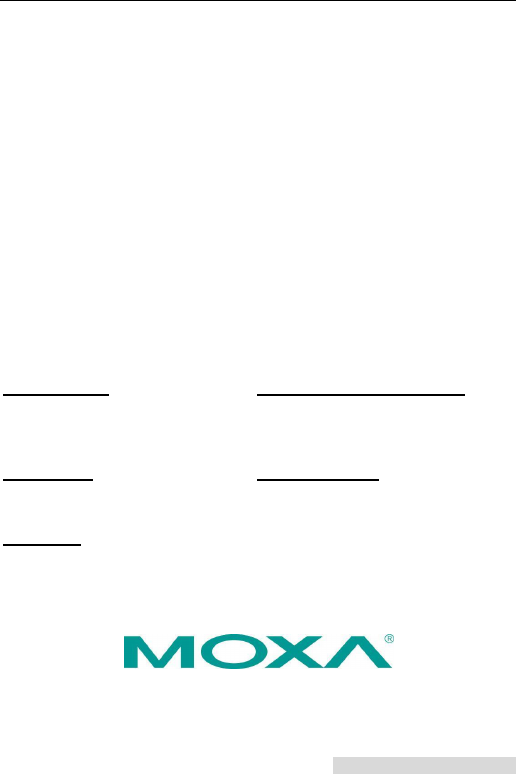
AWK-1137C
Quick Installation Guide
Moxa AirWorks
Edition 1.0, August 2017
Technical Support Contact Information
www.moxa.com/support
Moxa Americas:
Moxa China (Shanghai office):
Toll-free: 1-888-669-2872
Toll-free: 800-820-5036
Tel:
1-714-528-6777
Tel: +86-21-5258-9955
Fax:
1-714-528-6778
Fax: +86-21-5258-5505
Moxa Europe:
Moxa Asia-Pacific:
Tel:
+49-89-3 70 03 99-0
Tel:
+886-2-8919-1230
Fax:
+49-89-3 70 03 99-99
Fax:
+886-2-8919-1231
Moxa India:
Tel:
+91-80-4172-9088
Fax:
+91-80-4132-1045
2017 Moxa Inc. All rights reserved.
P/N: 1802011370010
*1802011370010*
Industrial 802.11a/b/g/n Serial/Ethernet to Wireless Client
Table of Contents
Overview ...............................................................................
- 3 -
Hardware Setup ....................................................................
- 3 -
Package Checklist ..............................................................
- 3 -
Panel Layout of the AWK-1137C ..........................................
- 4 -
Mounting Dimensions .........................................................
- 6 -
DIN-Rail Mounting .............................................................
- 6 -
Wall Mounting (Optional) ....................................................
- 6 -
Wiring Requirements .........................................................
- 8 -
Grounding the Moxa AWK-1137C .........................................
- 9 -
Installing Cable Extended Antennas for Outdoor Applications- 9 -
Wiring the Redundant Power Inputs ...................................
- 10 -
Using the Reset Button .....................................................
- 10 -
Activating AeroMag Function ........................................
- 10 -
Installing the Antenna Locking Clamp .................................
- 11 -
Communication Connections .............................................
- 11 -
10/100BaseT(X) Ethernet Port Connection .....................
- 11 -
RS-232/422/485 Serial Port ..............................................
- 11 -
LED Indicators ................................................................
- 12 -
Specifications .................................................................
- 12 -
Software Setup ...................................................................
- 16 -
How to Access the AWK ....................................................
- 16 -
First-Time Quick Configuration ..........................................
- 17 -
Point-to-Multipoint Scenario (AP/Client Mode) ................
- 17 -
Point-to-Point Scenario (slave mode) ..................
- 19 -
- 2 -
Overview
The AWK-1137C industrial Wi-Fi client meets the growing need for
faster data transmission speeds and wider coverage by supporting IEEE
802.11n technology with a net data rate of up to 300 Mbps. The AWK-
1137C combines two adjacent 20 MHz channels into a single 40 MHz
channel to deliver a potent combination of greater reliability and more
bandwidth. The AWK-1137C can operate on either the 2.4 or the 5 GHz
band and is backward compatible with existing 802.11a/b/g
deployments.
Hardware Setup
This section covers the hardware setup for the AWK-1137C.
Package Checklist
Moxa’s AWK-1137C is shipped with the following items. If any of these
items is missing or damaged, please contact your customer service
representative for assistance.
• 1 AWK-1137C wireless client
• 2 2.4/5 GHz antennas: ANT-WDB-ARM-0202
• DIN-rail kit
• Quick installation guide (printed)
• Warranty card
- 3 -

Panel Layout of the AWK-1137C
1. System LEDs: SYS, WLAN,
LAN1, LAN2, and SERIAL
2. LAN1: 10/100 BaseT(X) RJ45
port
3. LAN2: 10/100 BaseT(X) RJ45
port
4. RS-232/422/485 DB9 serial port
5. 3-pin terminal block
(ground/-/+)
6. M3 screw holes for antenna
bracket
7. Antenna B SMA
8. Antenna A SMA
- 4 -

9. 3-pin maintenance port for
engineers
10. Reset button
11. Screw holes for DIN-
rail mounting kit
12. Screw holes for wall-
mounting kit
- 5 -
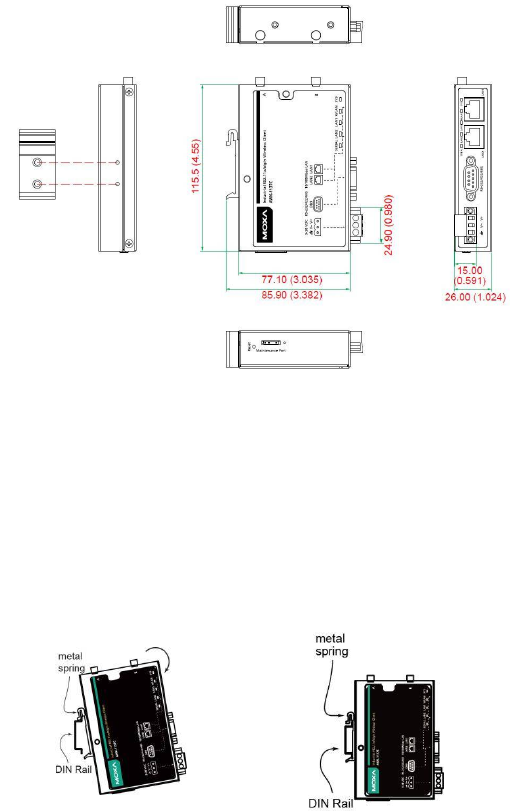
Mounting Dimensions
Unit = mm (inch)
DIN-Rail Mounting
The aluminum DIN-rail attachment plate comes attached to the back
panel of the AWK-1137C when you take it out of the box. If you need
to reattach the DIN-rail attachment plate to the AWK-1137C, make
sure the stiff metal spring is situated towards the top, as shown in the
figures below:
STEP 1:
Insert the top of the DIN rail
into the slot just below the stiff
metal spring.
STEP 2:
Gently push the device towards the DIN
rail until the DIN-rail attachment unit
snaps into place as shown below:
To remove the AWK-1137C from the DIN rail, reverse steps 1 and 2.
Wall Mounting (Optional)
For some applications, it may be more convenient to mount the
AWK-1137C to a wall, as illustrated below:
- 6 -
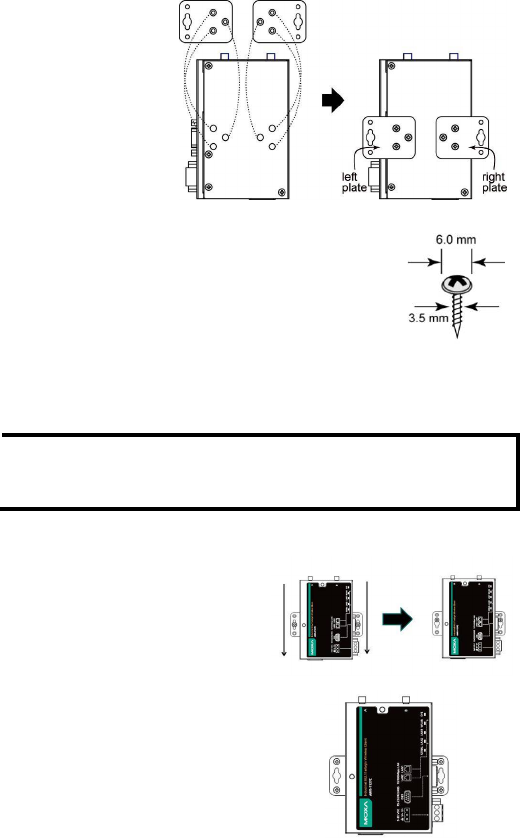
STEP 1:
Remove the aluminum
DIN-rail attachment
plate from the
AWK-1137C, and then
attach the
wall-mounting plates
with M3 screws, as
shown in the adjacent
diagrams.
STEP 2:
Mounting the AWK-1137C to a wall requires 2 screws.
Use the AWK-1137C device, with wall-mounting
plates attached, as a guide to mark the correct
locations of the 2 screws. The heads of the screws
should be less than 6.0 mm in diameter, and the
shafts should be less than 3.5 mm in diameter, as
shown in the figure on the right.
Do not drive the screws in all the way—leave a space of about 2 mm to
allow room for sliding the wall-mounting panel between the wall and
the screws.
NOTE Test the screw head and shank size by inserting the screws into
one of the keyhole shaped apertures of the wall-mounting
plates before they are fixed to the wall.
STEP 3a:
Once the screws are fixed into the
wall, insert the two screw heads
through the large opening of the
keyhole-shaped apertures, and then
slide the AWK-1137C downwards, as
indicated to the right. Tighten the
two screws for added stability.
STEP 3b:
Alternatively, insert four screws
directly through the AWK-1137C
into the wall.
- 7 -
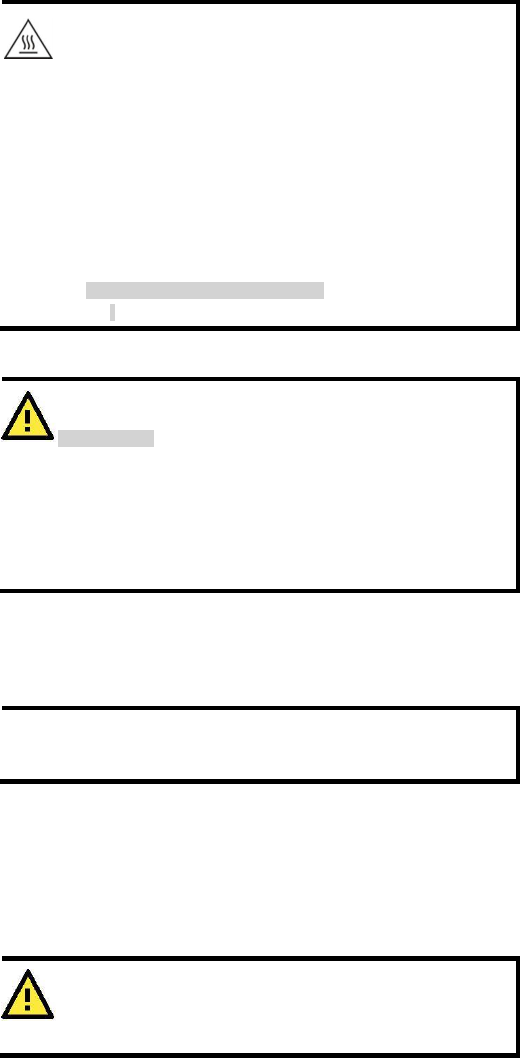
WARNING
• This equipment is intended to be used in a Restricted
Access Location, such as a dedicated computer room where
only authorized service personnel or users can gain access.
Such personnel must be instructed about the fact that the
metal chassis of the equipment is extremely hot and may
cause burns.
• Service personnel or users have to pay special attention and
take special precautions before handling this equipment.
• Only authorized, well-trained professionals should be
allowed to access the Restricted Access Location. Access
should be controlled by the authority responsible for the
location with lock and key or a security identity system.
• External metal parts are hot!! Pay special attention or
use special protection before handling this equipment.
Wiring Requirements
WARNING
Safety First!
Be sure to disconnect the power cord before installing
and/or wiring your Moxa AWK-1137C.
Calculate the maximum possible current in each power wire and
common wire. Observe all electrical codes that dictate the
maximum current allowed for each wire size. If the current
goes above the maximum ratings, the wiring could overheat,
causing serious damage to your equipment.
You should also pay attention to the following items:
• Use separate paths to route wiring for power and devices. If power
wiring and device wiring paths must cross, make sure the wires are
perpendicular at the intersection point.
NOTE Do not run signal or communications wiring and power wiring in
the same wire conduit. To avoid interference, wires with
different signal characteristics should be routed separately.
• You can use the type of signal transmitted through a wire to
determine which wires should be kept separate. The rule of thumb
is that wiring with similar electrical characteristics can be bundled
together.
• Keep input wiring and output wiring separate.
• It is strongly advised that you label wiring to all devices in the
system when necessary.
ATTENTION
This product is intended to be supplied by a Listed Power
Unit marked “Class 2” or “LPS” and rated O/P: 11.79 W.
- 8 -
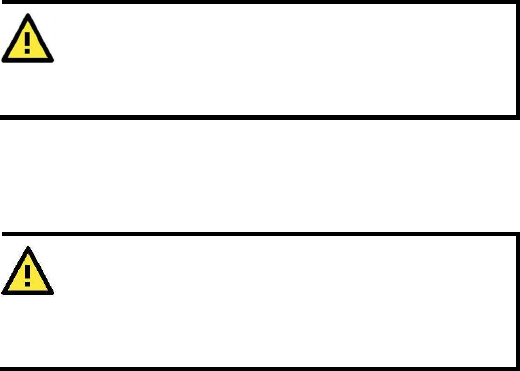
ATTENTION
Make sure the external power adapter (includes power cords
and plug assemblies) provided with the unit is certified and
suitable for use in your country.
Grounding the Moxa AWK-1137C
Grounding and wire routing help limit the effects of noise due to
electromagnetic interference (EMI). Run the ground connection from
the ground screw to the grounding surface prior to connecting devices.
ATTENTION
This product is intended to be mounted to a well-grounded mounting
surface, such as a metal panel. There must be no electrical potential
difference between any two grounding points; otherwise, there is a
risk that the device could be destroyed.
- 9 -
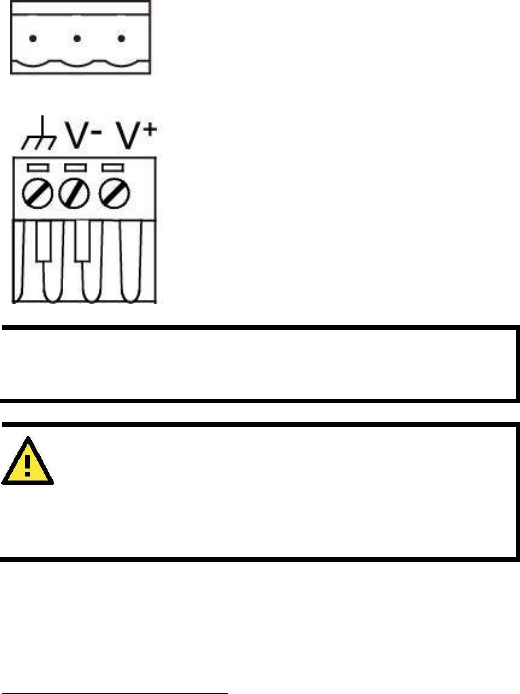
Wiring the Redundant Power Inputs
The top two pairs of contacts of the 10-contact terminal block
connector on the AWK-1137C’s top panel are used for the AWK-1137C’s
two DC inputs. Top and front views of the terminal block connector are
shown below:
STEP 1:
Insert the negative/positive DC wires into
the V-/V+ terminals.
STEP 2:
To keep the DC wires from pulling loose, use a
small flat-blade screwdriver to tighten the
wire-clamp screws on the front of the terminal
block connector.
STEP 3:
Insert the plastic terminal block connector
prongs into the terminal block receptor, which
is located on the AWK-1137C’s side panel.
NOTE Input Terminal Block (CN1) is suitable for wire size range of
12-28 AWG (3.31-0.0804 mm²) and a torque value of 4.5 lb-
in (0.51 Nm)
ATTENTION
If the AWK-1137C is connected to a motor or other similar type
of equipment, be sure to use power isolation protection. Before
connecting the AWK-1137C to the DC power inputs, make sure
the DC power source voltage is stable.
Using the Reset Button
The Reset button is used to load the factory default settings. Use a
pointed object to hold the Reset button down for five seconds to load
the factory defaults.
Activating AeroMag Function
Push the Reset Button 5 times to activate AeroMag. To deactivate it
again, push the Reset Button 3 times.
- 10 -
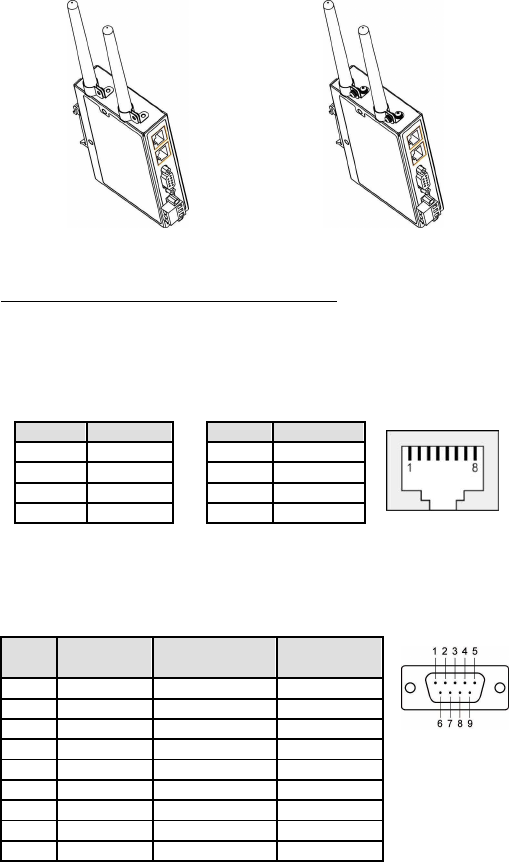
Installing the Antenna Locking Clamp
Utilize the antenna locking clamp to secure the antennas to the
AWK-1137C for added stability when you install the device in a
high-vibration environment.
STEP 1:
Slide the clamps into the antenna
port.
STEP 2:
Use screw to fix the clamps to the
side panel of the AWK-1137C as
shown below:
Communication Connections
10/100BaseT(X) Ethernet Port Connection
The 10/100BaseT(X) ports located on the AWK-1137C’s front panel
are used to connect to Ethernet-enabled devices.
The pinouts for both the
MDI (NIC-type) and MDI-X (HUB/switch-type)
ports as shown below:
MDI Port Pinouts
MDI-X Port Pinouts
8-pin RJ45
Pin
Signal
Pin
Signal
1
Tx+
1
Rx+
2
Tx-
2
Rx-
3
Rx+
3
Tx+
6
Rx-
6
Tx-
RS-232/422/485 Serial Port
The AWK-1137C has 1 RS-232/422/485 serial port with DB9 connector
for serial to WLAN connectivity. The pin assignments for the serial port
are shown below:
Pin
RS-232
RS-422/485
RS-485
(4W)
(2W)
1
DCD
TxD-(A)
–
2
RxD
TxD+(B)
–
3
TxD
RxD+(B)
Data+(B)
4
DTR
RxD-(A)
Data-(A)
5
GND
GND
GND
6
DSR
–
–
7
RTS
–
–
8
CTS
–
–
9
–
–
–
- 11 -
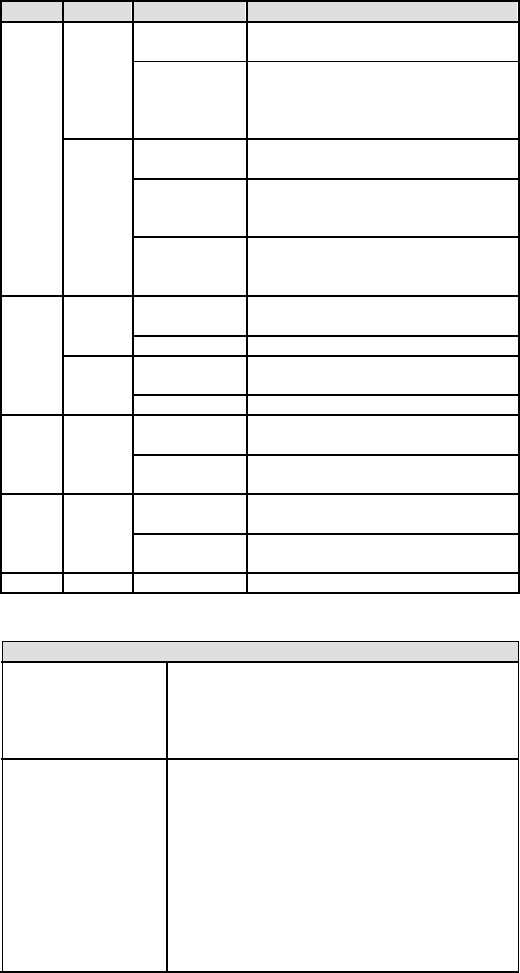
LED Indicators
The front and side panel of the Moxa AWK-1137C contains several LED
indicators. The function of each LED is described in the table below:
LED
Color
State
Description
On
System start up complete and the
system is in operation
Green
Blinking +
Device has been located by the
Beeps
Wireless Search Utility
(Interval: 1
second)
SYS
On
System is booting or a system booting
error has occurred
Blinking
IP address conflict
Red
(Interval: 0.5
second)
Blinking
Cannot obtain an IP address from
(Interval: 1
DHCP server
second)
Green
On
WLAN interface has connected
(RSSI > 35)
WLAN
Blinking
Data communication via WLAN
Amber
On
WLAN interface has connected
(RSSI < 35)
Blinking
Data communication via WLAN
LAN1
On
Ethernet LAN 1 interface has
Green
connected
Blinking
Data communication via Ethernet LAN
1
LAN2
On
Ethernet LAN 2 interface has
Green
connected
Blinking
Data communication via Ethernet LAN
2
Serial
Amber
Blinking
Data Transmission via serial data port
Specifications
WLAN Interface
Standards
IEEE 802.11a/b/g/n for Wireless LAN
IEEE 802.11i for Wireless Security
IEEE 802.3 for 10BaseT
IEEE 802.3u for 100BaseT(X)
IEEE 802.1Q VLAN
Spread Spectrum and
• DSSS with DBPSK, DQPSK, CCK
Modulation (typical)
• OFDM with BPSK, QPSK, 16QAM, 64QAM
• 802.11b: CCK @ 11/5.5 Mbps, DQPSK @ 2
Mbps, DBPSK @ 1 Mbps
• 802.11a/g: 64QAM @ 54/48 Mbps, 16QAM @
36/24 Mbps, QPSK @ 18/12 Mbps, BPSK @
9/6 Mbps
• 802.11n: 64QAM @ 300 Mbps to BPSK @ 6.5
Mbps (multiple rates supported)
- 12 -

Operating Channels
US:
(central frequency)
• 2.412 to 2.462 GHz (11 channels)
• 5.180 to 5.240 (4 channels)
• 5.260 to 5.320 (4 channels)
• 5.500 to 5.700 GHz (8 channels, excluding
5.600 to 5.640 GHz)
• 5.745 to 5.825 GHz (5 channels)
EU:
• 2.412 to 2.472 GHz (13 channels)
• 5.180 to 5.240 GHz (4 channels)
• 5.260 to 5.320 GHz (4 channels)
• 5.500 to 5.700 GHz (11 channels)
JP:
• 2.412 to 2.484 GHz (14 channels)
• 5.180 to 5.240 GHz (4 channels)
• 5.260 to 5.320 GHz (4 channels)
• 5.500 to 5.700 GHz (11 channels)
Security
• SSID broadcast enable/disable
• Firewall for MAC/IP/Protocol/Port-based
filtering
• 64-bit and 128-bit WEP encryption
• WPA/WPA2-Personal and Enterprise (IEEE
802.1X/RADIUS, TKIP, and AES)
Transmission Rates
• 802.11b: 1, 2, 5.5, 11 Mbps
• 802.11a/g: 6, 9, 12, 18, 24, 36, 48, 54 Mbps
• 802.11n: 6.5 to 300 Mbps (multiple rates
supported)
Transmitter Power
802.11b:
• Typ. 26±1.5 dBm @ 1 Mbps
• Typ. 26±1.5 dBm @ 2 Mbps
• Typ. 26±1.5 dBm @ 5.5 Mbps
• Typ. 25±1.5 dBm @ 11 Mbps
802.11g:
• Typ. 23±1.5 dBm @ 6 to 24 Mbps
• Typ. 22±1.5 dBm @ 36 Mbps
• Typ. 20±1.5 dBm @ 48 Mbps
• Typ. 19±1.5 dBm @ 54 Mbps
802.11n (2.4 GHz):
• Typ. 23±1.5 dBm @ MCS0/8 20 MHz,
• Typ. 17±1.5 dBm @ MCS7/15 20 MHz
• Typ. 23±1.5 dBm @ MCS0/8 40 MHz,
• Typ. 17±1.5 dBm @ MCS7/15 40 MHz
802.11a:
• Typ. 23±1.5 dBm @ 6 to 24 Mbps
• Typ. 21±1.5 dBm @ 36 Mbps
• Typ. 20±1.5 dBm @ 48 Mbps
• Typ. 18±1.5 dBm @ 54 Mbps
802.11n (5 GHz):
• Typ. 23±1.5 dBm @ MCS0/8 20 MHz,
• Typ. 18±1.5 dBm @ MCS7/15 20 MHz
• Typ. 23±1.5 dBm @ MCS0/8 40 MHz,
• Typ. 18±1.5 dBm @ MCS7/15 40 MHz
Note: Based on regional regulations, the maximum transmission
power allowed on the UNII bands is restricted in the firmware, as
indicated below:
- 13 -
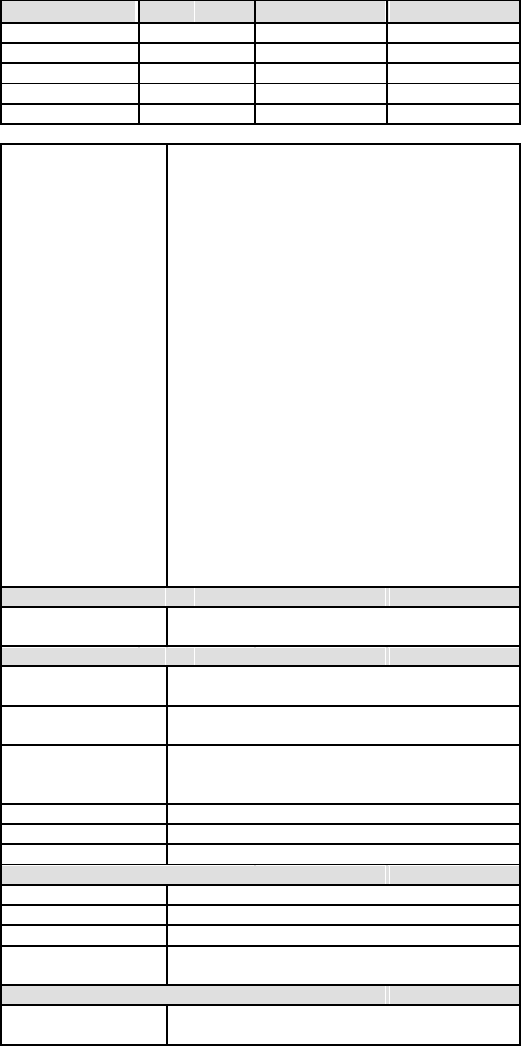
US
EU
JP
2.4 GHz
26 dBm
18 dBm
18 dBm
5 GHz (UNII-1)
23 dBm
23 dBm
23 dBm
5 GHz (UNII-2)
23 dBm
23 dBm
23 dBm
5 GHz (UNII-2e)
23 dBm
23 dBm
23 dBm
5 GHz (UNII-3)
23 dBm
--
--
Receiver Sensitivity
•
802.11b:
-89 dBm @ 1 Mbps, -89 dBm @ 2 Mbps
-89 dBm @ 5.5 Mbps, -88 dBm @ 11 Mbps
• 802.11g:
-88 dBm @ 6 Mbps, -88 dBm @ 9 Mbps
-88 dBm @ 12 Mbps, -87 dBm @ 18 Mbps
-84 dBm @ 24 Mbps, -81 dBm @ 36 Mbps
-77 dBm @ 48 Mbps, -75 dBm @ 54 Mbps
• 802.11n (2.4 GHz):
-70 dBm @ MCS7 20 MHz,
-70 dBm @ MCS15 20 MHz,
-64 dBm @ MCS7 40 MHz,
-65 dBm @ MCS15 40 MHz
• 802.11a:
-90 dBm @ 6 Mbps, -88 dBm @ 9 Mbps
-87 dBm @ 12 Mbps, -85 dBm @ 18 Mbps
-81 dBm @ 24 Mbps, -78 dBm @ 36 Mbps
-74 dBm @ 48 Mbps, -73 dBm @ 54 Mbps
• 802.11n (5 GHz):
-69 dBm @ MCS7 20 MHz,
-70 dBm @ MCS15 20 MHz,
-64 dBm @ MCS7 40 MHz,
-66 dBm @ MCS15 40 MHz
Protocol Support
General Protocols
Proxy ARP, DNS, HTTP, HTTPS, IP, ICMP, SNTP,
TCP, UDP, RADIUS, SNMP, DHCP, VLAN
Interface
Default Antennas
2 dual-band omni-directional antennas, 1.88 dBi,
RP-SMA (male)
Connector for External
RP-SMA (female), 500 V insulation
Antennas
LAN Ports
2, RJ45, 10/100BaseT(X) auto negotiation speed,
F/H duplex mode, and auto MDI/MDI-X
connection
Serial Port
1, RS-232/422/485, DB9 male connector
Reset
Present
LED Indicators
SYS, WLAN, LAN1, LAN2, Serial
Physical Characteristics
Housing
Metal, providing IP30 protection
Weight
470 g (1.03 lb)
Dimensions
77.1 x 115.5 x 26 mm (3.035 x 4.55 x 1.024 in)
Installation
DIN-rail mounting (standard),
wall mounting (optional)
Environmental Limits
Operating
Standard Models: 0 to 60°C (32 to 140°F)
Temperature
Wide Temp. Models: -40 to 75°C (-40 to 167°F)
- 14 -
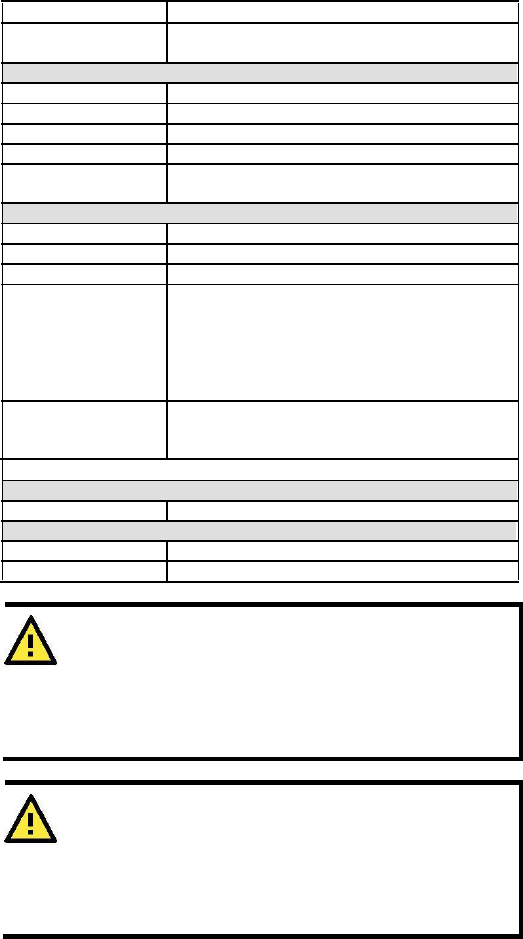
Storage Temperature
-40 to 85°C (-40 to 185°F)
Ambient Relative
5% to 95% (non-condensing)
Humidity
Power Requirements
Input Voltage
9 to 30 VDC
Input Current
1.3 A @9 VDC, 0.39 A @30 VDC
Connector
3-pin removable terminal block, 500 V insulation
Power Consumption 11.7 W
Reverse Polarity
Present
Protection
Standards and Certifications
Safety
UL 60950-1, EN 60950-1
EMC
EN 61000-6-2/61000-6-4
EMI
CISPR 22, FCC Part 15B Class B
EMS
IEC 61000-4-2 ESD: Contact 8 kV; Air 15 kV
IEC 61000-4-3 RS: 80 MHz to 1 GHz: 10 V/m
IEC 61000-4-4 EFT: Power 2 kV; Signal 1 kV
IEC 61000-4-5 Surge: Power 2 kV; Signal 1 kV
IEC 61000-4-6 CS: 10 V
IEC 61000-4-8
Radio
EN 301 489-1/17, EN 300 328, EN 301 893, MIC,
FCC ID SLE-1137C, WPC, ANATEL, KC, RCM,
SRRC
Note: Check Moxa’s website for the most up-to-date certification status.
Reliability
MTBF
1,125,942 hrs
Warranty
Warranty Period
5 years
Details
See www.moxa.com/support/warranty.aspx
ATTENTION
• The AWK-1137C is NOT a portable mobile device and should be
located at least 20 cm away from the human body.
• The AWK-1137C is NOT designed for the general public. A
well-trained technician is required to deploy AWK-1137Cs
and safely establish a wireless network.
ATTENTION
Use the antennas correctly: The 2.4 GHz antennas are needed
when the AWK-1137C operates in IEEE 802.11b/g/n. The 5 GHz
antennas are needed for operation in IEEE802.11a/n. Make
sure that the antennas are installed in a safe area, which is
covered by a lightning protection or surge arrest system.
- 15 -
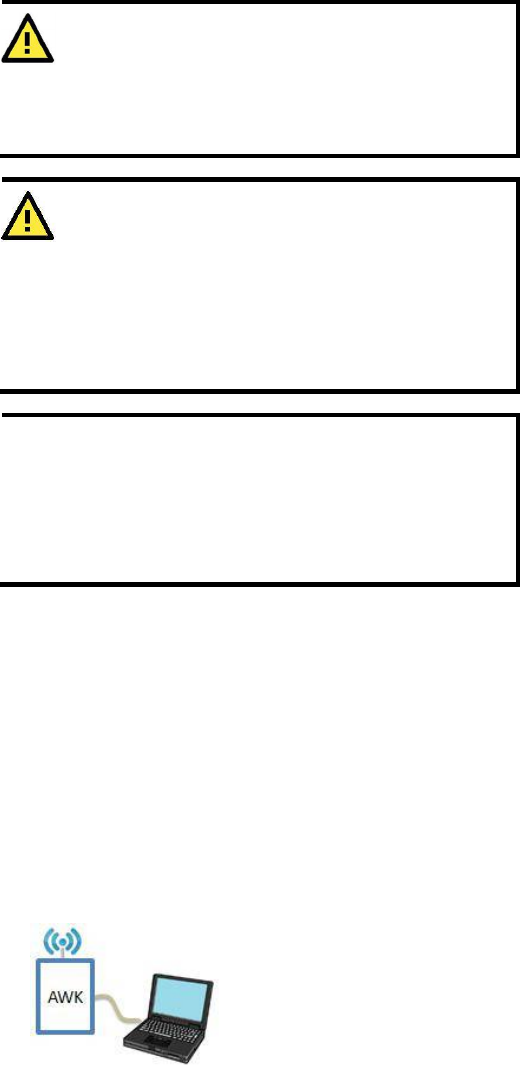
ATTENTION
This device complies with part 15 of the FCC Rules. The
operation of this device is subject to the following conditions:
1. This device must not cause harmful interference.
2. This device must accept any interference received, including
interference that may cause undesired operations.
ATTENTION
Do not locate the antenna near overhead power lines or other
electric light or power circuits, or where it can come into contact
with such circuits. When installing the antenna, take extreme care
not to come into contact with such circuits, because they may cause
serious injury or death. For proper installation and grounding of the
antenna, refer to national and local codes (for example, U.S.: NFPA
70; National Electrical Code (NEC) Article 810; Canada: Canadian
Electrical Code, Section 54).
NOTE For installation flexibility, you may select either antenna A or
antenna B on the top panel. Make sure the antenna connection
matches the antennas configured in the AWK-1137C web
interface.
To protect the connectors and RF module, all radio ports should
be terminated by either an antenna or a terminator. We
strongly recommend using resistive terminators for terminating
the unused antenna ports.
Software Setup
This section covers the software setup for AWK models in general.
How to Access the AWK
Before installing the AWK device (AWK), make sure that all items in the
package checklist are provided in the product box. You will also need access
to a notebook computer or PC equipped with an Ethernet port.
•Step 1: Select a suitable power source and plug in the AWK.
The AWK can be powered by DC power ranging from 12 VDC to 48
VDC.
•Step 2: Connect the AWK to the notebook or PC via the
AWK’s LAN port.
The LED indicator on the AWK’s LAN port will light up when a
connection is established.
- 16 -
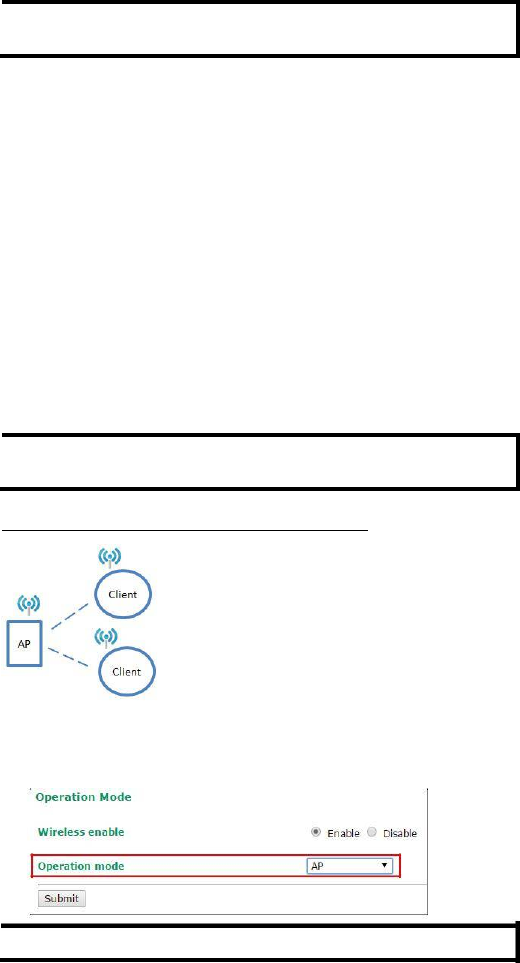
NOTE If you are using an Ethernet-to-USB adapter, follow the
instructions in the user’s manual provided with the adapter.
•Step 3: Set up the computer’s IP address
Choose an IP address for the computer that is on the same subnet as the
AWK. Since the AWK’s default IP address is 192.168.127.253, and the
subnet mask is 255.255.255.0, set the IP address to
192.168.127.xxx, where xxx is a value between 1 and 252.
•Step 4: Access the homepage of the AWK.
Open your computer’s web browser and type
http://192.168.127.253 in the address field to access the AWK’s
homepage. Log in using the following default username and
password:
Default Username: admin
Default Password: moxa
Click the Login button to access the homepage of the AWK device.
First-Time Quick Configuration
After successfully accessing the AWK, refer to the appropriate
subsection below to quickly set up a wireless network.
NOTE Ensure that there are no IP address conflicts when you
configure more than one AWK on the same subnet.
Point-to-Multipoint Scenario (AP/Client Mode)
Configuring the AWK as an AP
•Step 1: Set the operation mode of the AWK to AP mode. Go to
Wireless LAN Setup Operation Mode and select AP.
NOTE The default operation mode for the AWK is AP.
- 17 -
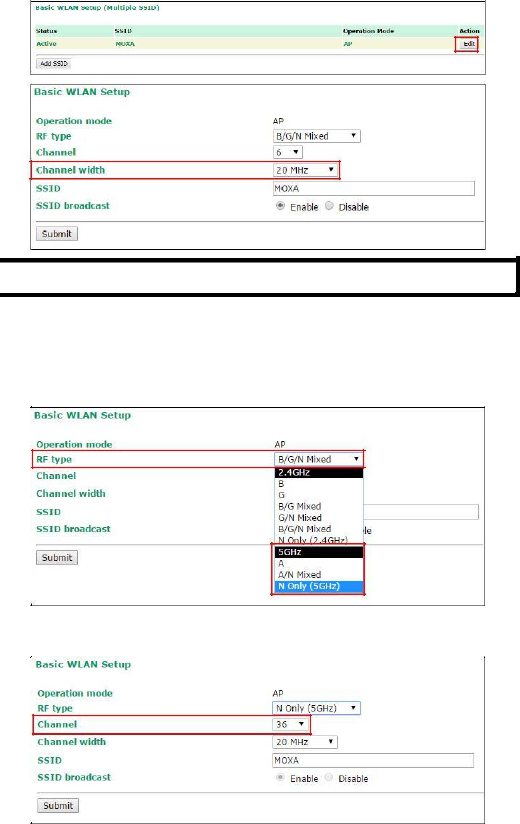
•Step 2: Set up your own SSID.
Go to Wireless LAN Setup WLAN Basic WLAN Setup
and click Edit to set the SSID.
NOTE The default SSID is MOXA.
•Step 3: Set the RF type and Channel for the AWK.
Go to Wireless LAN Setup WLAN Basic WLAN Setup.
We recommend that you choose the RF type 5 GHz for a relative
clean medium with minimum interference.
For the Channel setting, we recommend that you choose a channel
other than the default channel to avoid interference.
Click Submit to apply the changes, and restart the AWK in AP
mode to complete the configuration process.
- 18 -
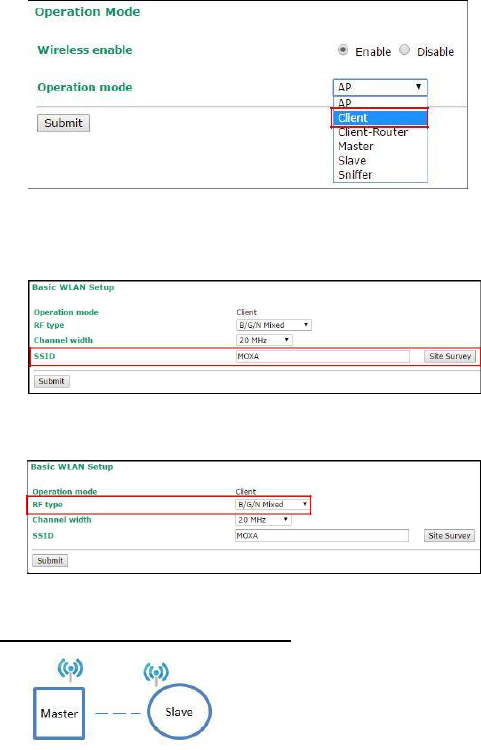
Configuring the AWK as a Client
•Step 1: Set the operation mode of the AWK to Client mode.
Go to Wireless LAN Setup Operation Mode, set the operation
mode to Client, and then click Submit to apply the change.
•Step 2: Link to an existing SSID.
Go to Wireless LAN Setup WLAN Basic WLAN Setup
and click Site Survey to select an existing SSID, or directly
enter an existing SSID in the text field.
•Step 3: Set the RF type and Channel settings for the AWK.
On the Wireless LAN Setup WLAN Basic WLAN Setup
page, edit the RF type and Channel settings.
Click Submit to apply the changes, and restart the AWK in client
mode to complete the configuration process.
Point-to-Point Scenario (slave mode)
- 19 -
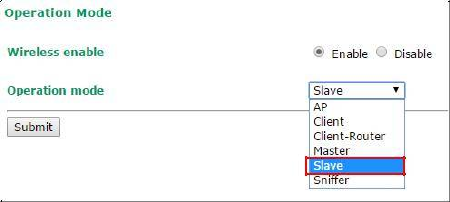
Configuring the AWK as a Slave
•Step 1: Set the operation mode of the AWK to Slave mode.
Go to Wireless LAN Setup Operation Mode, set the operation
mode to Slave, and then click Submit to apply the change.
•Step 2: Link to an existing SSID.
Go to Wireless LAN Setup WLAN Basic WLAN Setup
and click Site Survey to select an existing SSID, or directly enter
an existing SSID in the text field.
•Step 3: Set the RF type for the AWK.
On the Wireless LAN Setup WLAN Basic WLAN Setup
page edit the RF type setting.
Click Submit to apply the changes, and restart the AWK in
slave mode to complete the configuration process.
- 20 -

FEDERAL COMMUNICATIONS COMMISSION INTERFERENCE STATEMENT
This equipment has been tested and found to comply with the limits for a Class B digital
device, pursuant to part 15 of the FCC Rules. These limits are designed to provide
reasonable protection against harmful interference in a residential installation. This
equipment generates, uses and can radiate radio frequency energy and, if not installed
and used in accordance with the instructions, may cause harmful interference to radio
communications. However, there is no guarantee that interference will not occur in a
particular installation. If this equipment does cause harmful interference to radio or
television reception, which can be determined by turning the equipment off and on, the
user is encouraged to try to correct the interference by one or more of the following
measures:
-Reorient or relocate the receiving antenna.
-Increase the separation between the equipment and receiver.
-Connect the equipment into an outlet on a circuit different from that to which the
receiver is connected.
-Consult the dealer or an experienced radio/ TV technician for help.
CAUTION:
Any changes or modifications not expressly approved by the grantee of this device
could void the user's authority to operate the equipment.
RF exposure warning
This equipment must be installed and operated in accordance with provided
instructions and the antenna(s) used for this transmitter must be installed to provide
a separation distance of at least 20 cm from all persons and must not be co-located
or operating in conjunction with any other antenna or transmitter. End-users and
installers must be provide with antenna installation instructions and transmitter
operating conditions for satisfying RF exposure compliance.
This radio transmitter FCCID: SLE-1137C has been approved by FCC to operate with the
antenna types listed below with the maximum permissible gain and required antenna
impedance for each antenna type indicated. Antenna types not included in this list,
having a gain greater than the maximum gain indicated for that type, are strictly
prohibited for use with this device.
Antenna List
No.
Company
Part No.
Antenna Type
Peak Gain
1
Moxa ANT-WDB-ARM-0202
Omni
-
directional
Antenna
1.8dBi for 2.4 GHz
1.8dBi for 5.150-5.250 GHz
1.6dBi for 5.250-5.350 GHz
1.8dBi for 5.470-5.725 GHz
1.8dBi For 5.725~5.850GHz
Note: The antenna connector is Reverse SMA type
本產品符合低功率電波輻射性電機管理辦法第十二條、第十四條等條文規定:
經型式認證合格之低功率射頻電機, 非經許可,公司, 商號或使用者均不得
擅自變更頻率,加大功率或變更原設計之特性及功能。
低功率射頻電機之使用不得影響飛航影響安全及干擾合法通信, 經發現有干
擾現象時,應立即停用,並改善至無干擾時方得繼續使用。
前項合法通信,指一電信法規定作業之無線電通信低功率射頻電機需忍受合
法通信或工業,科學及醫療用電波輻射性電機設備之干擾。